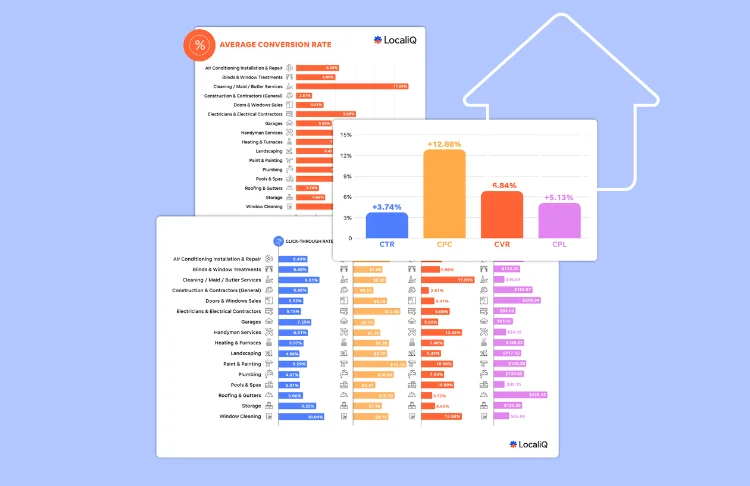If you want to generate more healthcare leads, you’ll need to be present in as many places and channels as possible.
Why? Because it’s a complex path to your clinic’s front door.
Patients may learn about you from a Google search, watching a video on social media, reviewing a healthcare directory, or meeting you at a health fair. And in many cases, it’s some combination of touchpoints that leads to a booked appointment.
In this guide, we’ll show you how to find healthcare leads from 11 sources. From building trust with reviews to driving traffic and conversions on your website, you’ll see how to create a multi-channel lead-generation system that captures new patients…no matter how they might find you.
Here are 11 sources of healthcare leads you can tap into again and again:
- Use on-site SEO
- Maximize business directories
- Optimize your website
- Be active on social media
- Run targeted paid ads
- Get and respond to reviews
- Establish a referral program
- Host and attend community events
- Guest star on local media outlets
- Build a network with local businesses
- Nurture leads
1. Use on-site SEO to attract visitors
Most people say an online search is the easiest way to learn about a healthcare provider. That’s probably why at least 60% of patients run a search when looking for a hospital, dentist, or physician.
Search engine optimization (SEO) helps make sure your website shows up in more of those searches. Two of the easiest ways to improve your healthcare site’s SEO are by writing search-optimized content and adding title tags and meta descriptions.
Title tags and meta descriptions
Title tags are the HTML code that shows the title of a page on your website. Meta descriptions are the brief explanations of what a page is about, also in HTML code.
Both title tags and meta descriptions show up in search results.


Make sure to keep both meta and title tags concise and use SEO keywords to help search engines and searchers understand your web pages.
🎯 Choosing the right keywords is critical to attract traffic that turns into healthcare leads. This free Complete Guide to Local Keywords will help you hit that target.
Search-optimized content
Writing and posting search-optimized content has a dual effect on your website. It adds topical authority so search engines surface your web pages in more results. It also builds trust with visitors as they seek an experienced professional.

Building a blog full of search-optimized content like this one helps your website attract and engage new healthcare leads.
The goal of SEO content is to post about topics that people search for and that bring qualified healthcare leads to your website. A few examples include:
- Your services: Articles describing your services will surface when people search for things like “dental implants” or “sports massage near me.”
- Your staff: If someone’s looking for a “board-certified podiatrist in Oklahoma City,” you want to be at the top of their results.
- Common questions: An article you write about “how to treat a child’s fever” can bring people who are dealing with that to your website.
2. Maximize business directories
Online business directories, or business listing sites, are platforms that gather information about local businesses so people searching can find and compare service providers. For healthcare professionals, it’s critical to have exposure on business directories or risk losing leads to competitors.
For healthcare providers, like urgent care facilities, directories come in three types:
- Local search results like Google Business Profiles and Bing Business Listings
- General business listings sites like Yelp
- Healthcare-specific directories like ZocDoc and Healthgrades

With a little effort, your practice can get top billing on the most popular business listing pages.
The good and bad news is that these information aggregators may create a citation for you. That’s great for the exposure, but it’s bad if they scrape incorrect or out-of-date information (a bad phone number or hours of operation will frustrate would-be patients).
To make sure you’re not chasing away healthcare leads on directories, first, claim your listings. Then optimize listings with images, a business description, and FAQs.
You’ll need to manage your listings periodically. That means checking to make sure the details and images are up to date. There are plenty of tools to help you do it.
👋 Don’t guess on the quality of your business listings. Use our free Listings Grader to check your listings on 50+ of the top online directories.
3. Optimize your website for healthcare lead generation
OK, we’ve got interested people coming to your website from search engines and directories. Let’s make sure your website is ready to convert them into leads.
Include clear CTAs
Calls to action are the bits of copy that tell website visitors what they should do next. Usually, CTAs guide people one step closer to becoming a customer.

This page nails its CTAs with contrasting colors and clear copy.
CTAs are important, so they should be clear, concise, and stand out on your web pages. That means giving them the most visible real estate and placing them in links and buttons that visually contrast with the rest of the page.
Use chatbots
People come to your website at all times looking for answers. Chatbots are a great way to greet inquisitive website visitors 24/7 without overworking your staff. Plus, chatbots can capture new leads for you automatically.

You can use chatbots to schedule appointments, gather symptoms, answer billing questions, and more.
Chatbots are already popular with healthcare providers—65% of practices report using them—and most say they get a positive ROI. Since one of the most popular uses of chatbots is to schedule appointments, they’re clearly a useful lead generation tool for medical clinics.
Pop-ups
Website popups are a well-tested lead generation tactic in many industries. Copy this strategy and you’ll start capturing more leads from your healthcare website, too.
There are three keys to using popups that generate leads (and don’t annoy your visitors):
- Choose when to show them: You can set popups to appear when someone first lands on the page, when they show signs of leaving, or when they spend a set amount of time (or scroll) on a page.
- Offer a valuable lead magnet: Each popup should offer something in return for a visitor giving up their contact details. A lead magnet could be a discounted session, educational content, or free assessment.
- A/B testing: A/B test various aspects of each popup from the offer to the copy and see which attracts the most leads.
4. Be active on social media
Interesting fact: Nearly 50% of people said social media is their main source of health and wellness information. It kind of makes sense, since people spend several hours every week on social media (compared to a visit or two each year with a doctor).
That’s why social media is a great place to drive healthcare leads.
Unfortunately, publishing a sporadic post now and then isn’t a recipe for social media success. You’ll need to be a bit more intentional than that. Here are a few ways to do it.
Pick the right place and time
To get the best return on your time, find the social media apps your target patients are on and post when they’ll most likely see it.
For example, Facebook is more popular with older generations, while you’ll find more Gen Zers on TikTok.

And on Instagram, it’s better to post mid-day and mid-week than on nights and weekends.

In fact, just about every social media platform has an ebb and flow of attention. Here are the best times to post on:
Get visual
Nearly 60% of people get health info from visual-first platforms TikTok, Instagram, and YouTube.
Give the people what they want. Post longform, deep-dive videos to YouTube. Then chop those videos up into short, educational clips for TikTok and Instagram Reels.
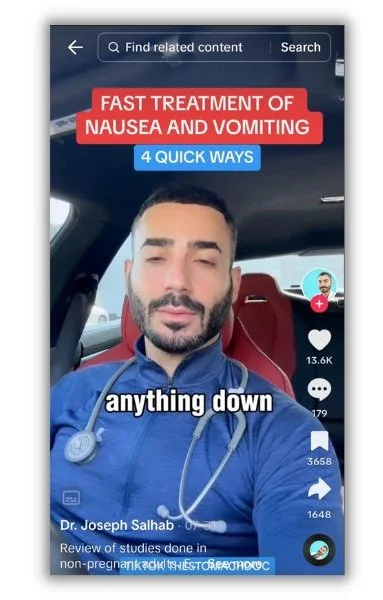
TikTok isn’t just for dance challenges. Lots of providers use it to connect with patients.
Keep it real (and right)
You know what the top two reasons people give for unfollowing a health account on social media? The content sounded fake, or it gave inaccurate information.
Here are a few tips to post a variety of content consistently without losing accuracy or authenticity:
- Share user generated content
- Create a social media calendar
- Jump on trends for easy ideas
Engage, engage, engage
The best part of social media is that it’s a two-way conversation (unlike a billboard, for example). Make the most of that feature by replying to comments on your posts, commenting on other accounts’ posts, and sharing content that’s relevant to your audience.

Keep social media social by replying and commenting often.
5. Run targeted paid ads
US healthcare marketers spending on ads is up 11.5% in 2022 and expected to jump another 10% in 2023. One of the reasons paid search and social media ads are so popular is because you can hyper-target them to very specific audiences.
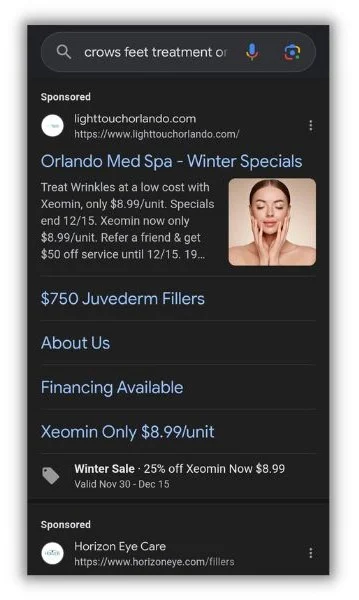
Ads show at the top of Google searches so they get lots of attention from people who most need your services.
Want to reach 50-year-olds in southern Wisconsin who love to run? No problem. Just tell Google or Facebook that’s who you want to reach and it’s set.
You can even target an audience that’s similar to the people you already work with (look-a-like audience) or surface ads to people that pursue your website (remarketing).
6. Get and respond to reviews
Over half of patients said they trust online reviews when choosing a healthcare professional, so says research by Tebra. But that same group of people said they want to see lots (50 or more) reviews, and many of them should be recent to garner any amount of trust.
That means you’ll need to keep getting new, positive reviews, ideally on a variety of platforms like Google, Yelp, and Facebook.

Reviews and ratings show prominently on almost every platform people look to for healthcare providers.
How do you get more reviews? Here are a few options:
- Ask for them: Use in-person visits, emails, even invoices to ask patients to leave reviews.
- Make it easy: Put links to review sites on your website and in emails.
- Make it automatic: Add review requests to on-hold and chatbot scripts.
Don’t forget to share the positive and address the negative reviews. Positive reviews add social proof to web pages and social media posts. And those negative reviews? Well, 91% of patients say it’s important doctors respond to them.
7. Establish a referral program
Good ol’ word of mouth advertising is still one of the best ways to generate healthcare leads. Referral programs encourage people to share their positive experiences while letting you track how many leads it creates.
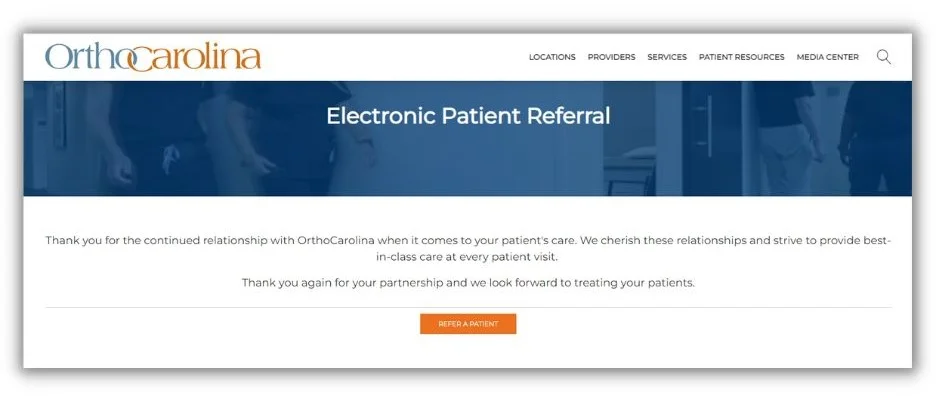
Patient referral programs should be “always on” so happy clients and send more leads your way.
There are a few questions you’ll need to ask while setting up your referral program:
- What will the current patient get in exchange for referring their friend? A discount, free session, or additional service are good options.
- How will they connect their friend to your business? It could be via social media or an online form sent by email.
- How will you promote your referral program? You could mention it during patient visits, send emails, or simply have signs with QR codes at the front desk.
8. Host and attend community events
Any time a group of people who may need your expertise gather, there’s an opportunity to build trust and find new leads for your practice.
Community events can be big or small, off or on line. The goal is to aim for events that your target audience will attend. Say you work with seniors, then a health fair at a community center could be good. If you’re a chiropractor, a 5K race will be more your speed.
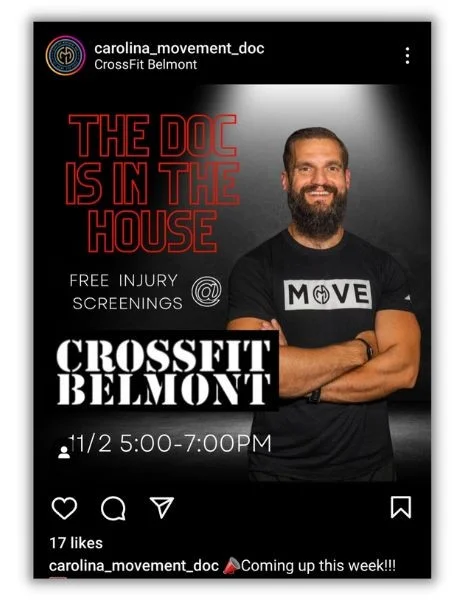
Getting out in the community can be as easy as visiting nearby gyms and yoga studios to talk about your specialty.
Webinars or “ask me anything” sessions in group chats are easy ways to provide value to a group of people online. Just make sure that no matter what events you choose, you’re gathering contact details so you can nurture the lead later (more on that in a bit).
9. Be a guest on local media outlets
There are opportunities to appear on local media outlets in pretty much every geographic market. The benefit is that you get to leverage the existing popularity of a show without all the work of building an audience.

Local morning news shows are a great option to get your practice in front of a large audience.
Are you comfortable being interviewed live? Or would you rather send answers to a journalist? Here are some of the ways you can be a guest, depending on your style:
- Television: Explain a health topic on a local morning show.
- Podcast: Get interviewed about your experience as a healthcare professional.
- Print: Be the source for an article.
- Radio: Join a panel to discuss something about your field.
You’ll need to do a little PR work. Pick a few outlets in your chosen media type. Then let the writers or producers know your areas of expertise and maybe a few topic ideas. They’re always looking for content, so you’ll help them out while they get you in front of an audience.
10. Build a network with local businesses
You might specialize in helping people eat well. Another professional sorts out their back problems. Yet another improves their sleep patterns. Why not work together and share leads so the patient gets all the care they need?
Building your network is as easy as reaching out on LinkedIn. Or introducing yourself at an event.
You can go beyond other healthcare professionals, too. What if the employees at your favorite running store dropped your name when their customers complained about lower back pain? Extend that idea to gyms and nutrition supplement stores, too.
11. Nurture leads
Any actions you take to convert leads into clients or patients is considered lead nurturing. So while lead nurturing isn’t actually generating new leads, it is a vital step in growing your healthcare business.
Email lead nurture campaigns are among the most common tactics marketers use to increase conversion rates. It’s how you’ll use the email address you gathered from website popups and going to events.
Don’t stop at emails, though. If you have permission, follow up via SMS texts, too. After all, 89% of consumers say they prefer texts to calls. Add a link so people can call your office with a single click.
Create a multi-faceted healthcare lead generation machine
Gone are the days of placing your practice in the Yellow Pages, buying some billboard space, and calling it a day. People find and research healthcare providers in a dozen different ways. To grow, you’ll need to be present in as many as possible.
Use the tips above to connect with new patients on and off line. Then look for ways to save time, like using AI to support your marketing efforts. With a little effort, all paths will lead to your clinic’s front door.

